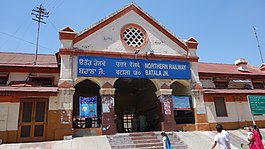Amritsar–Pathankot line
| Amritsar–Pathankot line (including Dera Baba Nanak branch line) | |||
|---|---|---|---|
 Batala Junction is an important railway station on Amritsar–Pathankot line | |||
| Overview | |||
| Status | Operational | ||
| Owner | Indian Railways | ||
| Locale | Punjab | ||
| Termini | Amritsar Pathankot Junction | ||
| Service | |||
| System | Electrified | ||
| Operator(s) | Northern Railway | ||
| History | |||
| Opened | 1884 | ||
| Technical | |||
| Track length | 108.9 km (68 mi) | ||
| Number of tracks | 1 (Single line) Doubling from Amritsar to Batala going on. | ||
| Track gauge | 5 ft 6 in (1,676 mm) broad gauge | ||
| Electrification | 2018 | ||
| Highest elevation | Amritsar 236 m (774 ft), Pathankot Junction 352 m (1,155 ft) | ||
| |||
The Amritsar–Pathankot line is a railway line connecting Amritsar and Pathankot Junction both in the Indian state of Punjab. The line is under the administrative jurisdiction of Northern Railway.
History[edit | edit source]
The 108.9 km (68 mi)-long 1,676 mm (5 ft 6 in)-wide 5 ft 6 in (1,676 mm) broad gauge Amritsar–Pathankot line was opened in 1884.[1] It originally belonged to the local government and was transferred to North Western Railway in 1892.[2] The Amritsar–Dera Baba Nanak branch line serves the western part of Batala tehsil. Prior to the partition of India in 1947, this line was 225.9 km (140 mi) long and was linked to Sialkot (now in Pakistan), but after partition Dera Baba Nanak became the terminus. The Batala–Qadian link serves the eastern part of Batala tehsil.[1] The 225.9 km (140 mi) long Amritsar–Sialkot line ran thus: Amritsar–Dera Baba Nanak–Narowal–Sialkot, crossing the 1.024 km (1 mi) long Ravi River Bridge.[3]
As of 2013, the Lahore–Narowal–Sialkot railway line passes near the India–Pakistan border through the western outskirts of Narowal, just opposite Dera Baba Nanak, before turning north-westwards to Pasrur and Sialkot.[4]
During the 2015 Gurdaspur attack, disaster was averted on this line as a railway lineman, Ashwani Saini, noticed a bomb on the track and alerted the authorities before the next train arrived. He also ran down the line waving a red flag to alert the driver of the next train to stop. The train that was due to traverse this track, with more than 270 people on board, stopped only a hundred yards from the bomb.[5]
Importance[edit | edit source]
This line is strategically very important. It connects three border districts of Punjab with each other namely Amritsar, Gurdaspur and Pathankot. This lines provides a diversion or substitute route to Jalandhar–Jammu line. Whenever this track gets interrupted either due to any protest or a technical/mechanical work, then most of the trains get diverted via Amritsar–Gurdaspur to Pathankot and further to Jammu and vice versa. This line can also play a strategic role and help military movement in war conditions. The important stations on this line are Amritsar, Batala, Gurdaspur & Pathankot. Other landmark stoppages are Verka, Dhariwal and Dinanagar.
Railway workshop[edit | edit source]
Amritsar railway workshop carries out periodic overhaul of WDS-4 locos and breakdown cranes and bogie manufacture.[6]
Passenger movement[edit | edit source]
Amritsar is the only station on this line which is amongst the top hundred booking stations of Indian Railway.[7]
Railway reorganisation[edit | edit source]
Sind Railway (later reorganised as Scinde, Punjab & Delhi Railway) was formed a guaranteed railway in 1856. It constructed broad-gauge railways from Delhi to Multan via Lahore, and from Karachi to Kotri. Multan and Kotri were connected by ferry service on the Indus River. In 1871–72, Indus Valley Railway was formed to connect Multan and Kotri. At the same time, Punjab Northern State Railway started constructing from Lahore towards Peshawar. In 1886, Sind, Punjab and Delhi Railway was acquired by the state and amalgamated with Indus Valley Railway and Punjab Northern State Railway to form North Western State Railway.[8]
With the partition of India in 1947, North Western Railway was split. While the western portion became Pakistan West Railway, and later Pakistan Railways, the eastern part became Eastern Punjab Railway.[9] In 1952, Northern Railway was formed with a portion of East Indian Railway Company west of Mughalsarai, Jodhpur Railway, Bikaner Railway and Eastern Punjab Railway.[10]
References[edit | edit source]
- ↑ 1.0 1.1 "Chapter VII". Archived from the original on 10 April 2009. Retrieved 10 February 2014.
- ↑ "Digital South Asia Library". Imperial Gazetteer of India, v. 20, p. 325. Retrieved 10 February 2014.
- ↑ Bhuyan, Mohan. "International Links from India". IRFCA. Retrieved 11 February 2014.
- ↑ Bajwa, Farooq (30 September 2013). From Kutch to Tashkent: The Indo-Pakistan War of 1965. London: C. Hurst & Co. (Publishers) Ltd. p. 256. ISBN 978-1-84904-230-7. Retrieved 11 February 2014 – via Google Books.
- ↑ Pubby, Vipin (28 July 2015). "How two Gurdaspur bravehearts foiled worst terror attack on Punjab". Daily O. Retrieved 28 July 2015.
- ↑ "Sheds and workshops". IRFCA. Retrieved 2 February 2014.
- ↑ "Indian Railways Passenger Reservation Enquiry". Availability in trains for Top 100 Booking Stations of Indian Railways. IRFCA. Archived from the original on 10 May 2014. Retrieved 10 February 2014.
- ↑ "Digital South Asia Library". Imperial Gazetteer of India, v. 3, p. 398. Archived from the original on 2 February 2014. Retrieved 31 January 2014.
- ↑ SM Imamul Haque (1989). Management of Indian Railways, 1989. ISBN 81-7099-183-8. Retrieved 31 January 2014 – via Google Books.
{{cite book}}:|work=ignored (help) - ↑ "Geography – Railway Zones". IRFCA. Retrieved 31 January 2014.